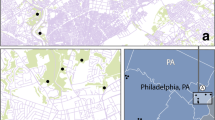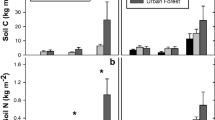Abstract
Urbanization displaces agriculture and natural ecosystems, constraining food security and carbon (C) sinks. A proposed solution, Urban Food Forestry (UFF), promises local food from trees that can sequester C faster than other land cover types as long as soil function can sustain increased above and belowground productivity. We compared fine-scale variation in soil physical, chemical and biological properties within and between UFF and traditional lawn for evidence of changes in belowground ecosystem services. Both land covers sequestered C, but UFF did so 834% faster, especially in upper soil strata where soil bulk density fell by 50% and microbial activity increased by 1167%. Species richness of both soil fungi and bacteria increased along with nutrient concentrations. Contrary to expectations, that different tree traits would drive increasing fine scale variability in C density, soils beneath the UFF became more uniform, which is consistent with the rapid emergence of system-level regulation. Soil C mass balance may distinguish forests from collections of trees and determine how long UFF helps cities store their carbon and eat it too.




Similar content being viewed by others
Data availability
All data necessary to reproduce the analysis is provided in Supplementary Information.
References
Albrecht A, Kandji ST (2003) Carbon sequestration in tropical agroforestry systems. Agric Ecosyst Environ 99:15–27. https://doi.org/10.1016/S0167-8809(03)00138-5
Alpizar L, Fassbender HW, Heuveldop J et al (1986) Modelling agroforestry systems of cacao ( Theobroma cacao ) with laurel ( Cordia alliodora ) and poro ( Erythrina poeppigiana ). Agrofor Syst 175–189
Baah-Acheamfour M, Chang SX, Carlyle CN, Bork EW (2015) Carbon pool size and stability are affected by trees and grassland cover types within agroforestry systems of western Canada. Agric Ecosyst Environ 213:105–113. https://doi.org/10.1016/j.agee.2015.07.016
Baruch Z, Liddicoat C, Cando-Dumancela C et al (2021) Increased plant species richness associates with greater soil bacterial diversity in urban green spaces. Environ Res 196:110425. https://doi.org/10.1016/j.envres.2020.110425
Baruch Z, Liddicoat C, Laws M et al (2020) Characterising the soil fungal microbiome in metropolitan green spaces across a vegetation biodiversity gradient. Fungal Ecol 47:100939. https://doi.org/10.1016/j.funeco.2020.100939
Beniston JW, Lal R, Mercer KL (2016) Assessing and Managing Soil Quality for Urban Agriculture in a Degraded Vacant Lot Soil. L Degrad Dev 27:996–1006. https://doi.org/10.1002/ldr.2342
Cardinael R, Chevallier T, Guenet B et al (2020) Organic carbon decomposition rates with depth and contribution of inorganic carbon to CO2 emissions under a Mediterranean agroforestry system. Eur J Soil Sci 71:909–923. https://doi.org/10.1111/ejss.12908
Cardoso EJBN, Vasconcellos RLF, Bini D et al (2013) Soil health: Looking for suitable indicators. What should be considered to assess the effects of use and management on soil health? Sci Agric 70:274–289. https://doi.org/10.1590/S0103-90162013000400009
Clark KH, Nicholas KA (2013) Introducing urban food forestry: A multifunctional approach to increase food security and provide ecosystem services. Landsc Ecol 28:1649–1669. https://doi.org/10.1007/s10980-013-9903-z
Cleveland DA, Phares N, Nightingale KD et al (2017) The potential for urban household vegetable gardens to reduce greenhouse gas emissions. Landsc Urban Plan 157:365–374. https://doi.org/10.1016/j.landurbplan.2016.07.008
Clivot H, Petitjean C, Marron N et al (2020) Early effects of temperate agroforestry practices on soil organic matter and microbial enzyme activity. Plant Soil 453:189–207. https://doi.org/10.1007/s11104-019-04320-6
Coleman K, Jenkinson DS, Crocker GJ et al (1997) Simulating trends in soil organic carbon in long-term experiments using RothC-26.3. Geoderma 81. https://doi.org/10.1016/S0016-7061(97)00079-7
Conner MM, Saunders WC, Bouwes N, Jordan C (2015) Evaluating impacts using a BACI design, ratios, and a Bayesian approach with a focus on restoration. Environ Monit Assess 188. https://doi.org/10.1007/s10661-016-5526-6
De Cáceres M, Legendre P (2020) Package “indicspecies.” CRAN Repos
De Stefano A, Jacobson MG (2018) Soil carbon sequestration in agroforestry systems: a meta-analysis. Agrofor Syst 92:285–299. https://doi.org/10.1007/s10457-017-0147-9
de Tombeur F, Sohy V, Chenu C et al (2018) Effects of permaculture practices on soil physicochemical properties and organic matter distribution in aggregates: A case study of the bec-hellouin farm (France). Front Environ Sci 6:1–12. https://doi.org/10.3389/fenvs.2018.00116
Díaz-Vallejo EJ, Seeley M, Smith AP, Marín-Spiotta E (2021) A meta-analysis of tropical land-use change effects on the soil microbiome: Emerging patterns and knowledge gaps. Biotropica 53. https://doi.org/10.1111/btp.12931
Dowd SE, Sun Y, Wolcott RD, Domingo A, Carroll JA (2008) Bacterial tag–encoded FLX amplicon pyrosequencing (bTEFAP) for microbiome studies: bacterial diversity in the ileum of newly weaned Salmonella-infected pigs. Foodborne Pathog Dis 5:459–472. https://doi.org/10.1089/fpd.2008.0107
Feliciano D, Ledo A, Hillier J, Nayak DR (2018) Which agroforestry options give the greatest soil and above ground carbon benefits in different world regions? Agric Ecosyst Environ 254:117–129. https://doi.org/10.1016/j.agee.2017.11.032
Forest Products Laboratory (2010) Wood Handbook: Wood as an Engineering Material. Agriculture 72:466. General Technical Report FPL-GTR-190
Guilland C, Maron PA, Damas O, Ranjard L (2018) Biodiversity of urban soils for sustainable cities. Environ Chem Lett 16:1267–1282. https://doi.org/10.1007/s10311-018-0751-6
Hackl E, Zechmeister-Boltenstern S, Bodrossy L, Sessitsch A (2004) Comparison of diversities and compositions of bacterial populations inhabiting natural forest soils. Appl Environ Microbiol 70:5057–5065. https://doi.org/10.1128/AEM.70.9.5057-5065.2004
Hoosbeek MR, Remme RP, Rusch GM (2018) Trees enhance soil carbon sequestration and nutrient cycling in a silvopastoral system in south-western Nicaragua. Agrofor Syst 92:263–273. https://doi.org/10.1007/s10457-016-0049-2
Hulvey KB, Hobbs RJ, Standish RJ et al (2013) Benefits of tree mixes in carbon plantings. Nat Clim Chang 3:869–874. https://doi.org/10.1038/nclimate1862
Huang JW, Hu SL, Cheng XK, Chen D, Kong XK, Jiang JD (2019) Steroidobacter soli sp. nov., isolated from farmland soil. Int J Syst Evol Microbiol 69:3443–3447. https://doi.org/10.1099/ijsem.0.003639
Klein T, Siegwolf RTW, Körner C (2016) Belowground carbon trade among tall trees in a temperate forest. Science 352. https://doi.org/10.1126/science.aad6188
Lee KH, Jose S (2003) Soil respiration and microbial biomass in a pecan - Cotton alley cropping system in southern USA. Agrofor Syst 58:45–54. https://doi.org/10.1023/A:1025404019211
Loreau M (2010) Linking biodiversity and ecosystems: towards a unifying ecological theory. Philos Trans R Soc Lond B Biol Sci 365:49–60. https://doi.org/10.1098/rstb.2009.0155
McDougall R, Kristiansen P, Rader R (2019) Small-scale urban agriculture results in high yields but requires judicious management of inputs to achieve sustainability. Proc Natl Acad Sci USA 116:129–134. https://doi.org/10.1073/pnas.1809707115
McElwee P, Calvin K, Campbell D et al (2020) The impact of interventions in the global land and agri-food sectors on Nature’s Contributions to People and the UN Sustainable Development Goals. Glob Chang Biol 26:4691–4721. https://doi.org/10.1111/gcb.15219
McMurdie PJ, Holmes S (2013) Phyloseq: an R package for reproducible interactive analysis and graphics of microbiome census data. PLoS One 8. https://doi.org/10.1371/journal.pone.0061217
Morais TG, Teixeira RFM, Domingos T (2019) Detailed global modelling of soil organic carbon in cropland, grassland and forest soils. PLoS One 14. https://doi.org/10.1371/journal.pone.0222604
Nagy R, Lockaby BG, Zipperer WC, Marzen LJ (2014) A comparison of carbon and nitrogen stocks among land uses/covers in coastal Florida. Urban Ecosyst 17:255–276. https://doi.org/10.1007/s11252-013-0312-5
Nawaz MF, Bourrié G, Trolard F (2013) Soil compaction impact and modelling. A Review Agron Sustain Dev 33:291–309. https://doi.org/10.1007/s13593-011-0071-8
Nguyen NH, Song Z, Bates ST et al (2016) FUNGuild: An open annotation tool for parsing fungal community datasets by ecological guild. Fungal Ecol 20. https://doi.org/10.1016/j.funeco.2015.06.006
Nytofte JLS, Henriksen CB (2019) Sustainable food production in a temperate climate – a case study analysis of the nutritional yield in a peri-urban food forest. Urban For Urban Green 45. https://doi.org/10.1016/j.ufug.2019.04.009
Ogle K, Barber JJ (2012) Bayesian Statistics. In: Hastings A, Gross L (eds) Sourcebook in theoretical ecology. University of California Press, Berkeley
Parada AE, Needham DM, Fuhrman JA (2016) Every base matters: assessing small subunit rRNA primers for marine microbiomes with mock communities, time series and global field samples. Environ Microbiol 18:1403–1414
Parton WJ, Stewart JWB, Cole CV (1988) Dynamics of C, N, P and S in grassland soils: a model. Biogeochemistry 5:109–131
Peach ME, Ogden LA, Mora EA, Friedland AJ (2019) Building houses and managing lawns could limit yard soil carbon for centuries. Carbon Balance Manage 14:1–14. https://doi.org/10.1186/s13021-019-0124-x
R Core Team (2020) R software: Version 4.0.2. R Found Stat Comput
Ren C, Wang T, Xu Y et al (2018) Differential soil microbial community responses to the linkage of soil organic carbon fractions with respiration across land-use changes. For Ecol Manage 409:170–178. https://doi.org/10.1016/j.foreco.2017.11.011
Salbitano F, Fini A, Borelli S, Konijnendijk CC (2019) Editorial - Urban Food Forestry: Current state and future perspectives. Urban For Urban Green 45. https://doi.org/10.1016/j.ufug.2019.126482
Schafer LJ, Lysák M, Henriksen CB (2019) Tree layer carbon stock quantification in a temperate food forest: A peri-urban polyculture case study. Urban For Urban Green 45:126466. https://doi.org/10.1016/j.ufug.2019.126466
Shi W, Bowman D, Rufty (2012) Microbial control of soil carbon accumulation in turfgrass systems. In: Lal R, Augustin B (eds) Carbon sequestration in urban ecosystems. Springer, Dordrecht, pp 215–231. https://doi.org/10.1007/978-94-007-2366-5_11
Smith P, House JI, Bustamante M et al (2016) Global change pressures on soils from land use and management. Glob Chang Biol 22:1008–1028. https://doi.org/10.1111/gcb.13068
Sparkman J, Bryant J (2016) New College of Florida campus master plan. https://www.ncf.edu/wp-content/uploads/2020/08/NCF-Masterplan_Amendment-1_August-2016.pdf. Accessed 17 Jan 2023
Soil Science Division Staff (2017) Soil survey manual. Ditzler C, Scheffe K, Monger HC (eds) USDA Handbook 18. Government Printing Office, Washington
Soil Survey Staff (2023) Soil Series Classification Database. Natural Resources Conservation Service, USDA. https://data.nal.usda.gov/dataset/soil-series-classification-database-sc. Accessed 17 Jan 2023
Tang YL, Lin HP, Xie QY, Li L, Peng F, Deng Z, Hong K (2013) Actinoallomurus acanthiterrae sp. nov., an actinomycete isolated from rhizosphere soil of the mangrove plant Acanthus ilicifolius. Int J Syst Evol Microbiol 63:1874–1879. https://doi.org/10.1099/ijs.0.043380-0
Thompson GL, Kao-Kniffin J (2019) Urban grassland management implications for soil C and N dynamics: a microbial perspective. Front Ecol Evol 7. https://doi.org/10.3389/fevo.2019.00315
Trumbore S (2000) Age of soil organic matter and soil respiration: Radiocarbon constraints on belowground C dynamics. Ecol Appl 10. https://doi.org/10.1890/1051-0761(2000)010[0399:AOSOMA]2.0.CO;2
USDA (1948) Aerial photographs of Sarasota County - Flight 1D (1948) http://ufdc.ufl.edu/UF00071781/00001. Accessed 17 Jan 2023
USDA (2011) U.S. Agriculture and Forestry Greenhouse Gas Inventory: 1990–2008. Hohenstein W (ed) Technical Bulletin 1930
Van Der Heijden MGA, Bardgett RD, Van Straalen NM (2008) The unseen majority: Soil microbes as drivers of plant diversity and productivity in terrestrial ecosystems. Ecol Lett 11:296–310. https://doi.org/10.1111/j.1461-0248.2007.01139.x
Walkley A, Black IA (1934) An examination of the degtjareff method for determining soil organic matter, and a proposed modification of the chromic acid titration method. Soil Sci 37. https://doi.org/10.1097/00010694-193401000-00003
Ward EB, Doroski DA, Felson AJ et al (2021) Positive long-term impacts of restoration on soils in an experimental urban forest. Ecol Appl 31:1–15. https://doi.org/10.1002/eap.2336
White TJ, Bruns T, Lee SJWT, Taylor J (1990) Amplification and direct sequencing of fungal ribosomal RNA genes for phylogenetics. In: Innis MA, Gelfand DH, Sninsky JJ, White TJ (eds) PCR protocols: a guide to methods and applications. Academic Press, San Diego, pp 315–322
Acknowledgements
Meghan Midgley, Joshua Breithaupt and Richard Hauer provided insightful comments on an early draft of this manuscript. An anonymous reviewer made excellent suggestions for improving the comparison between land cover types. Deniz Wilson and Deric Harvey completed informal surveys of the lawn habitat. New College of Florida students funded the land use experiment through the New College of Florida Green Fee. Additional funds for soil analyses were provided by the New College of Florida Foundation.
Funding
New College of Florida students funded the land use experiment through the New College of Florida Green Fee. Additional funds for soil analyses were provided by the New College of Florida Foundation.
Author information
Authors and Affiliations
Contributions
All authors contributed to the study conception and design. Material preparation and data collection were performed by Jay McWilliams and Steven Bressan. Data analysis was conducted by Brad Oberle and Erika Díaz-Almeyda. The first draft of the manuscript was written by Brad Oberle. All authors commented on previous versions of the manuscript. All authors read and approved the final manuscript.
Corresponding author
Ethics declarations
Ethics approval
Not applicable.
Competing interests
The authors have no relevant financial or non-financial competing interests to disclose.
Supplementary Information
Below is the link to the electronic supplementary material.
Rights and permissions
Springer Nature or its licensor (e.g. a society or other partner) holds exclusive rights to this article under a publishing agreement with the author(s) or other rightsholder(s); author self-archiving of the accepted manuscript version of this article is solely governed by the terms of such publishing agreement and applicable law.
About this article
Cite this article
Oberle, B., Bressan, S., McWilliams, J. et al. Urban food forestry transforms fine-scale soil function for rapid and uniform carbon sequestration. Urban Ecosyst 26, 1239–1250 (2023). https://doi.org/10.1007/s11252-023-01384-2
Accepted:
Published:
Issue Date:
DOI: https://doi.org/10.1007/s11252-023-01384-2




